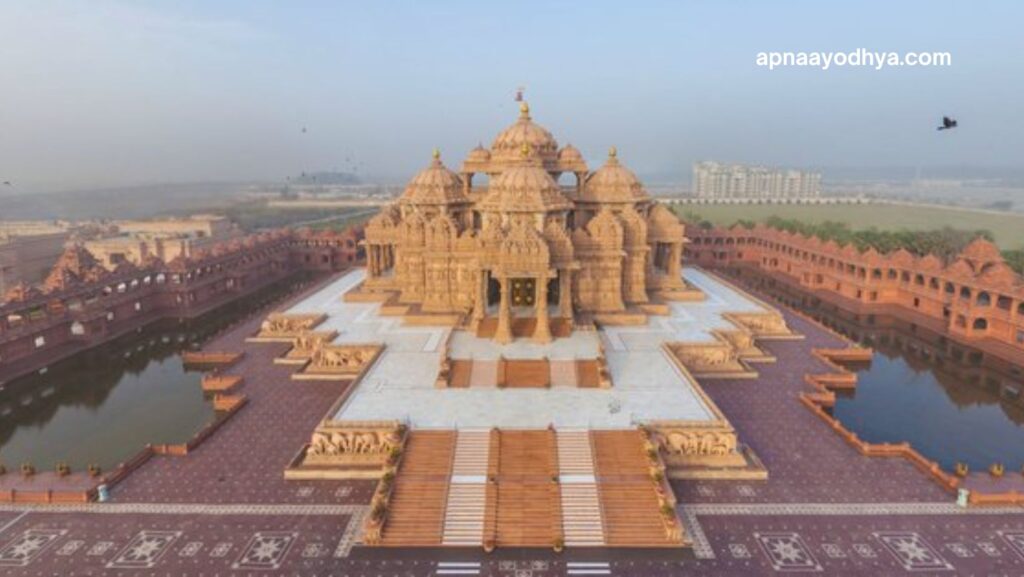In the heart of history and mythology, Ayodhya stands as a vibrant tribute to its deep spiritual importance and rich architectural legacy. Located on the hallowed banks of the Sarayu River in Uttar Pradesh, India, Ayodhya has long been a central hub of Hindu culture. Beyond being renowned as the sacred birthplace of Lord Rama, this ancient city boasts a splendid array of grand temples, each a testament to the seamless blend of diverse artistic styles and historical eras.
1. Ram Janmabhoomi Temple: The Heart of Ayodhya
The Ram Janmabhoomi Temple, nestled in the heart of Ayodhya’s rich cultural and religious heritage, carries profound sanctity as it is believed to be the hallowed birthplace of Lord Rama.This hallowed site stands as a paramount pilgrimage destination for Hindus, embodying centuries of historical evolution. Initially a humble shrine, the temple has evolved into its present-day magnificence, showcasing exquisite architecture and intricate carvings that bear testimony to the craftsmanship spanning diverse periods, including the Mughal and Maratha eras.

2. Hanuman Garhi Temple: A Marvel of Fortification
Perched atop a hill, the Hanuman Garhi Temple is a striking example of military architecture blended with devotion. The temple complex resembles a fortress, with its massive walls, bastions, and gates. Within the sacred confines of this place, worshippers offer their reverence to Lord Hanuman, the revered monkey god, enveloped by a tranquil and profoundly spiritual ambiance. The expansive vista of Ayodhya visible from this elevated perspective is nothing short of awe-inspiring. Within the sacred confines, worshipers offer their reverence to Lord Hanuman, the revered monkey deity, amidst an ambiance filled with serenity and profound spirituality. The breathtaking panoramic view of Ayodhya from this elevated perspective adds to the spiritual experience.
3. Kanak Bhavan: A Royal Abode for the Divine
Kanak Bhavan, also known as the Sone-ka-Ghar, is an exquisite temple dedicated to Lord Rama and his consort, Sita. This temple is famous for its golden interior, which is said to have been gifted by Queen Kaikeyi to Sita. The intricately designed interiors with golden motifs and chandeliers cast a mesmerizing glow, making it a unique spiritual experience.
Also read – The Majestic Role of Jatayu in Ramayana: Unraveling His Extraordinary Powers
4. Nageshwarnath Temple: An Ancient Abode of Shiva
Ayodhya, celebrated as the hallowed dwelling of Lord Rama, also embraces a profound significance for devotees of Lord Shiva. The Nageshwarnath Temple, an ancient and venerated shrine devoted to Lord Shiva, stands as a poignant reminder of the city’s deep-rooted spiritual legacy. With its timeless architecture, this temple offers a tranquil haven for meditation and devotion, inviting seekers to connect with the divine.
Also read – Light 21 lakh lamps on Deepotsav in Ayodhya this year: UP CM Yogi Adityanath
5. Treta Ke Thakur Temple: A Link to the Ramayana
Treta Ke Thakur Temple is a hidden gem that connects Ayodhya to the ancient epic, the Ramayana. According to legend, it is here that Lord Rama performed a sacred yajna (fire sacrifice) after returning from Lanka. The temple’s architecture transports visitors back in time, and the aura of divinity envelops all who enter its premises.
6. Other Temples of Ayodhya: A Diversity of Styles
Ayodhya is dotted with numerous other temples, each with its own unique architectural style and historical significance. From the opulent Rajadhiraj Temple to the serene and picturesque Tulsi Udyan, the city offers a diverse range of spiritual experiences.
Also read – The Pivotal Role of Angada in Ramayana
Preservation of Ayodhya’s Architectural Heritage
Ayodhya’s rich architectural heritage stands as a powerful testament to the city’s enduring cultural legacy, with centuries of rulers and dynasties leaving their indelible mark on the temples, creating a harmonious fusion of architectural styles. Preserving and safeguarding these historical treasures is of paramount importance to ensure that Ayodhya’s architectural heritage remains a source of inspiration, awe, and reverence for generations to come.
Also read – Ram Mandir: Remains of ancient temple found in excavation of Ram Janmabhoomi
In summary, Ayodhya’s temples transcend mere architectural structures; they are living manifestations of faith, history, and artistic craftsmanship. These temples serve as enduring symbols of spirituality and cultural opulence in this ancient city. Delving into Ayodhya’s architectural legacy is a voyage through history, offering a profound connection to the very foundations of Indian civilization. It extends an open invitation to witness the harmonious blend of devotion and architectural mastery in one of the world’s holiest locales.
Also read – Know About Ganesh Visarjan on Ganesh Chaturthi 2023
